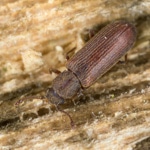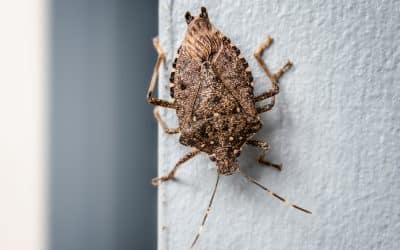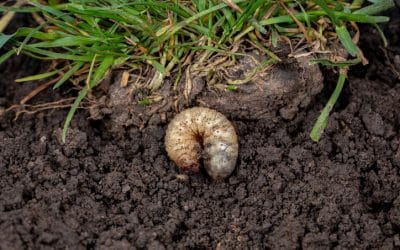
Pest Identification: Saw Tooth Grain Beetles
The saw-toothed grain beetle is a common stored-products pest throughout the world in homes, grocery stores, food warehouses, and grain storage facilities. These beetles feed on a variety of stored products including flour, cereals, bread, pasta, dried fruits, sugar, nuts, drugs, dried meat, and tobacco. With their flattened body, they easily hide in cracks and crevices, and can penetrate poorly packaged materials. A typical discovery of a saw-toothed grain beetle infestation occurs when the adult beetles are found crawling around in the pantry area. They favor warm, humid conditions and they are more active during the summer months. Not only do they contaminate food they also can create favorable conditions for growth of molds. Even though they eat and foul food, they are not known to cause any human health hazards.
The adult saw-toothed grain beetles are small, brown and have a flattened body 1/10-1/8 inch long with six saw-like teeth on the first segment behind the head. They do not fly and they are not attracted to light. The larvae are usually yellowish-white with a brown head and are less than 1/8 inch long when mature. The larvae are difficult to identify because they are nearly identical to other closely related grain beetles. The life cycle of the saw-toothed grain beetle revolves around food. The female adult lays her eggs individually or in small batches in and around a food supply. A female can lay 45 to 285 eggs per year. Larvae emerge from the eggs in 3 to 10 days, and usually mature into adults within 50 days depending on the temperature. Adult females live from 6 to 10 months, but can live up to 3 years if conditions are ideal.
Control of the saw-toothed grain beetle begins by finding the source or sources of the infestation. All infested foods must be removed and discarded. Vacuum the area thoroughly and physically remove any visible insects from the cabinets, floor, and walls of the kitchen. Proper ventilation is necessary to reduce the humid environment where these insects thrive. If infestations are found early, no pesticide treatment is necessary. If the infestation has gone on for a long period of time our professional technicians can spray a residual chemical to aid in the eradication of these pests.

Buzzwords
Flea FAQs: What You Need to Know
We’ve all been there: that tiny black spec…did it just move? If you’re a homeowner, few things can spark panic faster than spotting a flea in your carpet, on your bedding, or crawling on your pet. Fleas are annoying, but they also bite, can spread disease, and turn...
Bug Off! Keeping Stink Bugs Out of Your Home
Fall in New England brings crisp air, colorful leaves, and stink bugs. As soon as the temperatures start to dip, stink bugs start searching for a cozy spot to ride out the winter, and your home is often their top choice. Unless you know how to stop them. With a few...
Protect Your Lawn: What You Need to Know About Grubs
You work hard to maintain a beautiful yard. But if you start noticing unexplained patches or spongy turf, grubs might be the culprit. These pesky beetle larvae feed on grass roots, turning lush lawns into a patchy mess. Bottom line: they are a threat to your yard....


